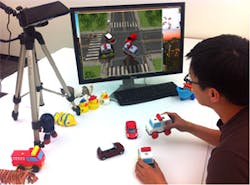Kinect system simplifies the art of puppetry
Researchers at the University of Washington (Seattle, WA, USA) and the University of California, Berkeley (Berkeley, CA, USA) have created a system that can enable even inexperienced puppeteers to produce 3-D animations.
To use the system, a puppeteer physically manipulates physical objects in front of a Kinect depth sensor. The system then uses a combination of image-feature matching and 3-D shape matching to identify and track the objects. It then renders the corresponding 3-D models into a virtual set.
The system operates in real time so that a puppeteer can immediately see the resulting animation and make adjustments on the fly. It also provides 6-D virtual camera and lighting controls, which the puppeteer can adjust before, during, or after a performance. Layered animations can be used to help puppeteers produce animations in which several characters move at the same time.
The researchers demonstrated the effectiveness of their system by showing how puppeteers with no prior experience could use it to create a variety of animations. Their work was presented earlier this month at the ACM Symposium on User Interface Software and Technology (UIST).
A technical article describing the development of the system entitled "3D Puppetry: A Kinect-based Interface for 3D Animation," can be found on the web here.
Related articles on the Kinect that you might also find of interest.
1. Kinect used to create 3-D death mask of Newton
Researchers at Microsoft Research Laboratory (Cambridge, UK) have used a Kinect camera to produce the first ever 3-D scan of Sir Isaac Newton's death mask.
2. How accurate is the Kinect?
An assistant professor at the Faculty of Geo-Information Science and Earth Observation of the University of Twente (Enschede, The Netherlands) has written a technical paper that analyses the accuracy and resolution of the depth data from the Microsoft Kinect sensor.
3. Kinect software assists physical therapists
The West Health Institute (La Jolla, CA, USA) has developed a software application for Microsoft's Kinect for Windows platform that can help physical therapists ensure that patients perform exercises correctly.
4. Free toolkit helps Labview developers interface to the Kinect
Researchers from the school of mechanical engineering at Leeds University (Leeds, UK) have been crowned winners of the Student Design Competition at National Instruments NI Week in Austin, Texas for creating a LabVIEW application programming interface (API) for Microsoft's Kinect software development toolkit (SDK).
5. Kinect could help medics estimate radiation dose from CT scanner
Researchers at the Hospital of the University of Pennsylvania are investigating whether a system based around the Microsoft Kinect could be used to help predict the precise dose of ionizing radiation that patients require during a CT scan by providing an accurate estimate of whole-body volume.
Vision Systems Design magazine and e-newsletter subscriptions are free to qualified professionals. To subscribe, please complete the form here.
-- Dave Wilson, Senior Editor, Vision Systems Design
